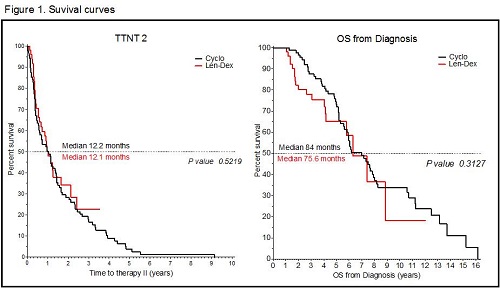Abstract: PB1998
Type: Publication Only
Background
The optimal management of relapsed Multiple Myeloma (MM) with respect to therapeutic combinations and sequence remains controversial and is actively evolving. Many commonly used regimens have not been directly compared. These agents vary widely in cost, and knowledge of their relative efficacy is of particular importance in regions where cancer medicines are publicly funded.
Aims
We sought to compare the efficacy and safety of two commonly used regimens for relapsed MM using historical cohorts from a single transplant center.
Methods
A retrospective observational study was performed between January 1991 and November 2016 to compare the efficacy of cyclophosphamide and dexamethasone/prednisone (Cyclo), or lenalidomide and dexamethasone (Len-Dex) for relapsed MM post autologous stem cell transplant (auto SCT). The primary outcome was Time to Next Treatment 2 (TTNT2), defined as time from first relapse requiring therapy after auto SCT to second relapse requiring therapy. The secondary outcome was overall survival, defined as time of diagnosis to death from any cause. Outcomes were assessed by Kaplan Meier methods and overall differences determined by log rank test. Hazard ratios were calculated for individual treatment groups and compared by univariate and multivariate logistic regression.
Results
A total of 243 patients underwent treatment for MM at first relapse post autologous transplant. Of these, 139 were included in this analysis: 88 Cyclo and 51 Len-Dex. Patient demographics and disease characteristics were similar between each group for age, sex, subtype of MM and ISS Stage (p>0.05). Vincristine, Doxorubicin and Dexamethasone (VAD) was the most common treatment at diagnosis for the Cyclo group (68%), whereas bortezomib-based therapy was the most common for the Len-dex group (76%) (p<0.0001). No differences were observed in overall response rate or depth of response based on induction therapy between both groups. Median time to first relapse requiring treatment after auto SCT was longer in the Cyclo group, 36 months vs. 25 months (p=0.0008). The median TTNT2 was similar for the two groups: 12.2 months (IQR, 4.56-27.96) for Cyclo and 12.1 months (IQR, 4.80-29.16) for Len-dex (p=0.52). However, after adjusting for standard patient and disease related factors in a multivariate model, TTNT2 was shorter for Cyclo compared to Len-dex (HR 2.29; 95% CI, 1.17 – 4.51; p=0.016). The median overall survival was 84 months for Cyclo and 75.6 months for Len-dex (p=0.31). In the multivariate analysis, overall survival was not different for Cyclo compared to Len-dex (HR 0.99; CI 0.42 – 2.34; p=0.99). There was no significant difference in rates of hospitalization, infection, or grade 3 adverse events between the two groups.

Conclusion
In this observational study of patients with relapsed multiple myeloma post autologous stem cell transplantation, Lenalidomide-dexamethasone was associated with longer TTNT2 compared with Cylophosphamide-glucocorticoids. However, there was no difference in overall survival. Cyclophosphamide is considerably less expensive than the novel agents. In an era when fiscally sustainable care for MM remains a challenge, further prospective studies are required to compare cyclophosphamide with novel agents in the management of relapsed multiple myeloma.
Session topic: 14. Myeloma and other monoclonal gammopathies - Clinical
Keyword(s): Survival, Relapse, Multiple Myeloma, Cyclophosphamide





